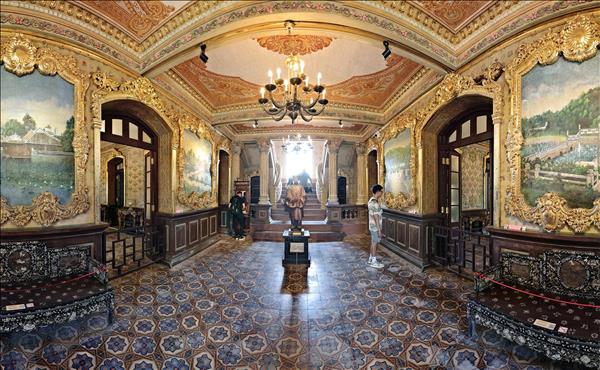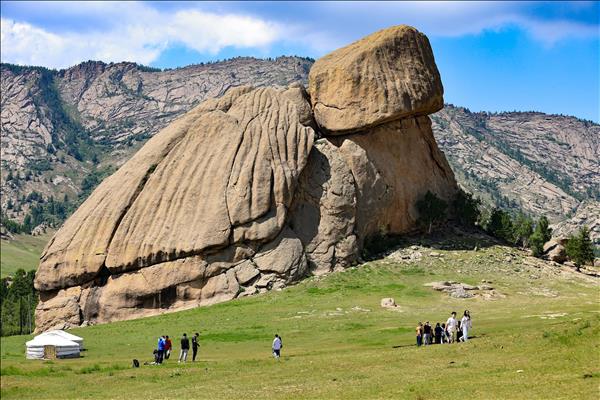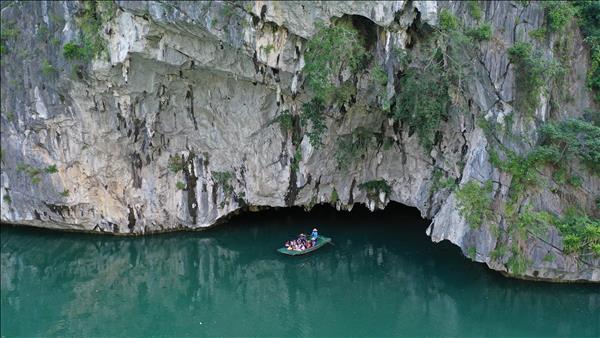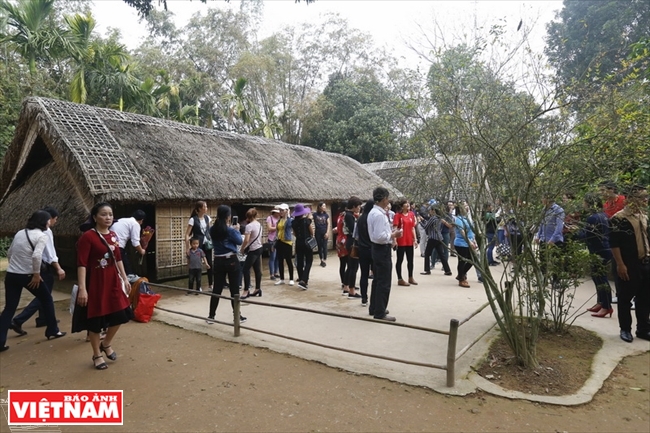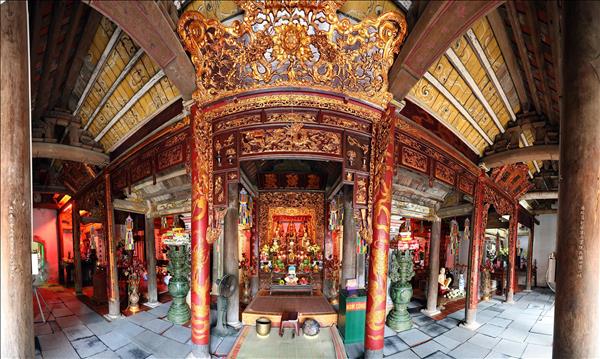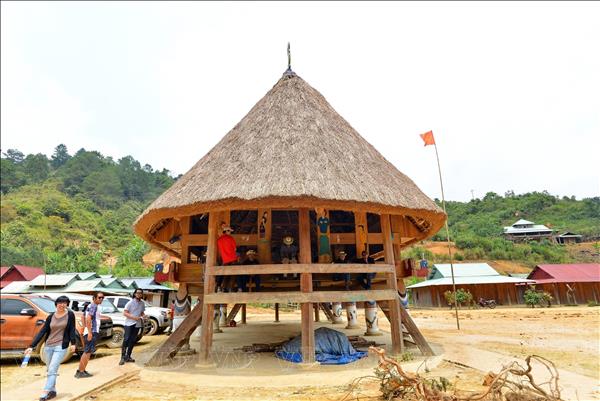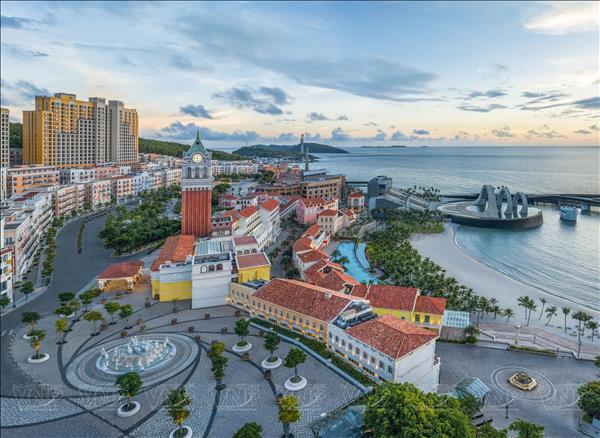The old imperial city of Hue is famous not only for its splendid palaces but also for the magnificence of the ancient tombs, temples, pagodas and shrines in a romantic natural setting.
When talking about the old architecture in Hue it is impossible not to mention the system of royal tombs of the Nguyen Kings. Each tomb is a masterpiece that shows not only the talent of the artisans in Hue but also the personality of each king.
The Nguyen Dynasty was the last feudal regime in Vietnamese history, which started when King Gia Long took over the throne in 1802 and ended in 1945 when King Bao Dai announced his abdication of the throne. The Nguyen Dynasty existed for 143 years with 13 emperors. Now, in Hue, there are seven tombs of seven of the Nguyen kings remaining. The most notable among them are the tombs of the Kings Gia Long, Minh Mang and Tu Duc.
Gia Long’s tomb (also called Thien Tho) is situated in an area consisting of 42 large and small mountains, in Huong Tho Commune, Huong Tra District, Thua Thien-Hue Province, about 16km southwest of downtown Hue. This is the final resting place of King Gia Long (1762-1820), the first emperor of the Nguyen Dynasty.
The Nguyen Dynasty was the last feudal regime in Vietnamese history, which started when King Gia Long took over the throne in 1802 and ended in 1945 when King Bao Dai announced his abdication of the throne. The Nguyen Dynasty existed for 143 years with 13 emperors. Now, in Hue, there are seven tombs of seven of the Nguyen kings remaining. The most notable among them are the tombs of the Kings Gia Long, Minh Mang and Tu Duc.
Gia Long’s tomb (also called Thien Tho) is situated in an area consisting of 42 large and small mountains, in Huong Tho Commune, Huong Tra District, Thua Thien-Hue Province, about 16km southwest of downtown Hue. This is the final resting place of King Gia Long (1762-1820), the first emperor of the Nguyen Dynasty.
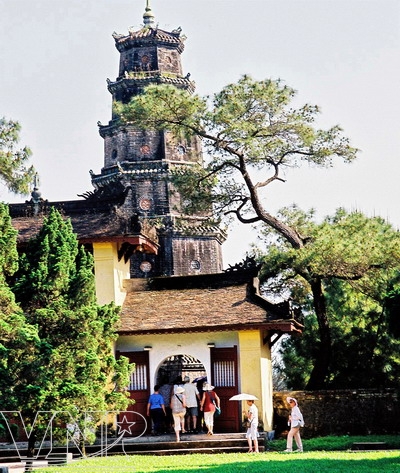 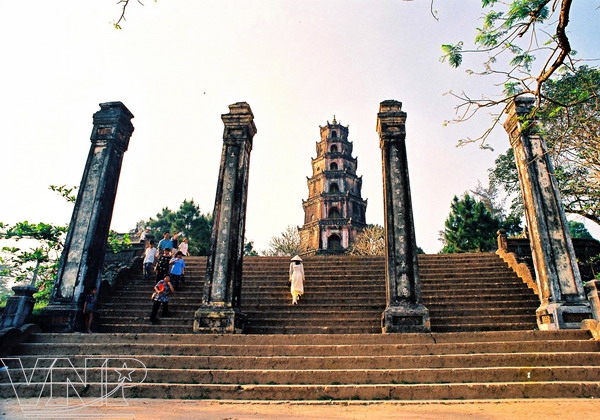 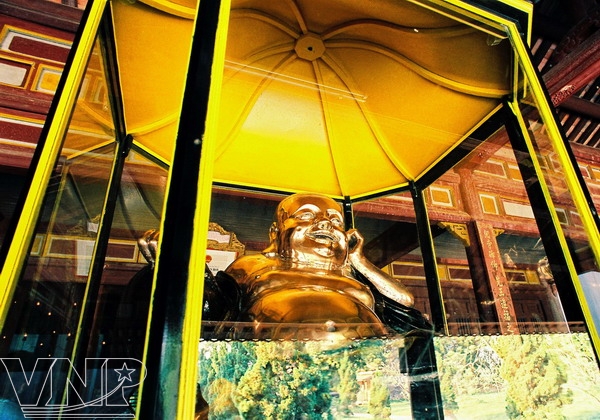 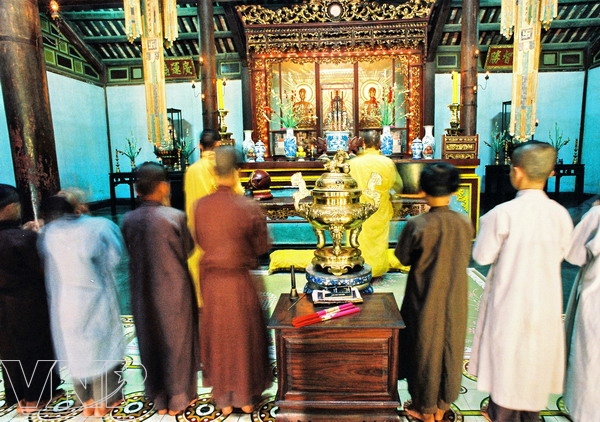 Thien Mu, one of the famous pagodas in Hue, was built in 1601 under the dynasty of Lord Nguyen Hoang. Photo: Trang Linh |
Built in 1814, Gia Long’s tomb is over 11,000m in circumference. In front of the tomb is Dai Thien Tho Mountain. On the left and right sides there are 14 mountains each, which flank the tomb in the form of “blue dragon on the left” and “white tiger on the right”. Inside the area where the tomb is located there is a semicircular lake, a courtyard for the king’s audience, a courtyard for an offerings ceremony with six steps and the Buu Thanh where the tombs of the king and queen were placed. Standing in this place people cannot help feeling small among a vast mountainous area.
About 12km southwest of downtown Hue, where the Huu Trach and Ta Trach Rivers merge into the Huong River, there is another famous tomb on Cam Khe Mountain in Huong Tho Commune, Huong Tra District, Thua Thien-Hue Province. It is Minh Mang’s tomb (also called Hieu), the resting place of King Minh Mang (1791-1841) who was the second emperor of the Nguyen Dynasty.
Covering an area of 26ha, Minh Mang’s tomb is an architectural complex of 40 structures in an open area of mountains and rivers. Construction of the tomb started in 1840 and was completed in 1843. Seen from above, the tomb looks like a person lying at ease, with the head resting on Kim Phung Mountain and the legs stretching to the confluence of rivers in front. The two halves of Trung Minh Lake on two sides of the tomb look like out stretched arms.
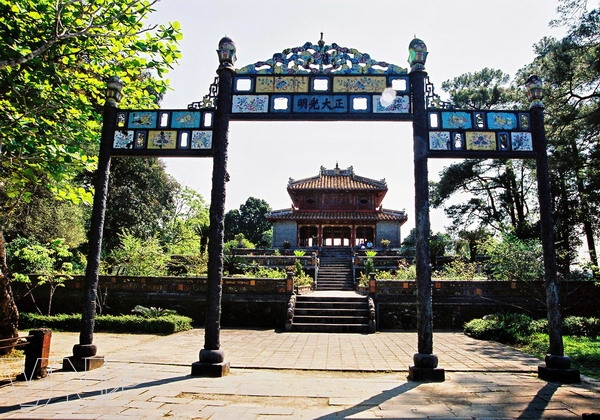 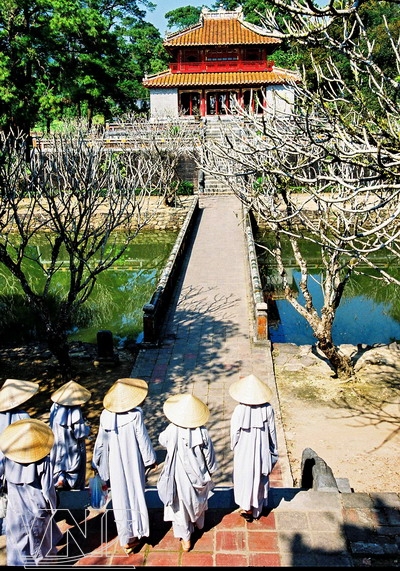 The final resting place of King Minh Mang (1791-1841) – the second emperor of the Nguyen Dynasty. Photo: Trang Linh |
The tomb was embellished by many beautiful structures and works of nature, such as lotus lake, the communal house, a flower garden, ornamental plants and a pine forest. There are three gates to the tomb: Dai Hong Mon in the middle, Ta Hong Mon on the left side and Huu Hong Mon on the right. Behind Dai Hong Mon gate is a courtyard for the king’s audience with two rows of stone statues of mandarins, elephants and horses. With a symmetric design, solemnity and beautiful scenery, Minh Mang’s tomb is very attractive.
The tomb of King Tu Duc (1829-1883), the fourth emperor of the Nguyen Dynasty is called Khiem Tomb (locally called Tu Duc). It was built in a forest of ancient pine trees in Duong Xuan Thuong Village (present-day Thuong Ba Hamlet, Thuy Xuan Ward), about 8km southwest of downtown Hue. This is one of the most beautiful works of the royal architecture in the Nguyen Dynasty. Construction of the tomb started in 1864 and was completed in 1867. When alive, King Tu Duc used to go to this place to relax, read books and recite poems.
Tu Duc’s tomb is situated in an area of about 12ha where there are nearly 50 architectural structures. Unlike other tombs of symmetric architecture which were commonly built in the Nguyen Dynasty, Tu Duc’s tomb has a liberal architectural style, just like the romantic personality of this poet emperor.
The panoramic view from Tu Duc’s tomb is like a large park. There are streams and paths paved with Bat Trang bricks under the shade of pine trees. The natural scenery around here is so beautiful that visitors to this place think it is a paradise of flowers and trees, not a tomb.
Tu Duc’s tomb has a place for the emperor to relax, recite poems, read books and work. It also has a theatre and a residence for the imperial concubines and pretty girls. In particular, there is a big stone stele inscribed with an article titled “Khiem cung ky” that consists of 4,935 scripts written by King Tu Duc. The article is about life, royalty and the emperor’s mistakes and wrong doings.
Of all the tombs of the Nguyen Kings, Khai Dinh’s tomb (also called Ung) is the only one mixed with Oriental and Occidental architecture. It is the resting place of King Khai Dinh (1885-1925), the 12th emperor of the Nguyen Dynasty. The tomb is situated on Chau Chu Mountain (also called Chau E) in Thuy Bang Commune, Huong Thuy District, Thua Thien – Hue Province, about 10km southwest of downtown Hue.
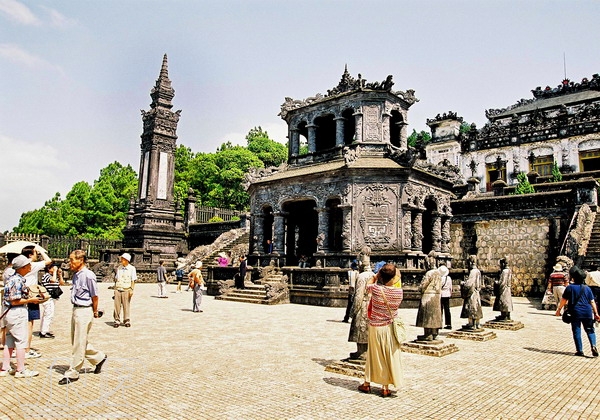 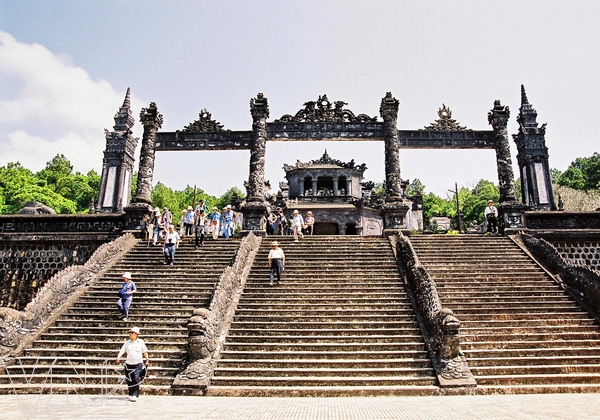 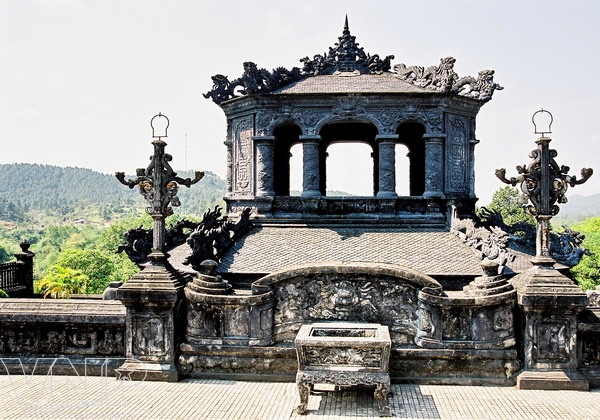 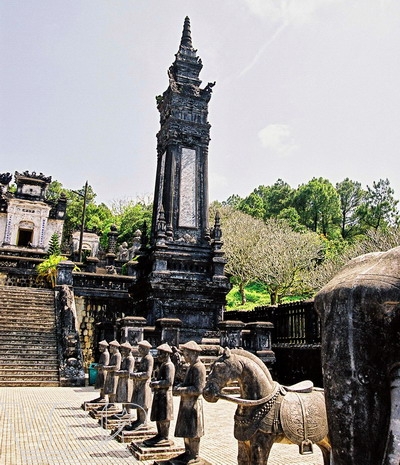 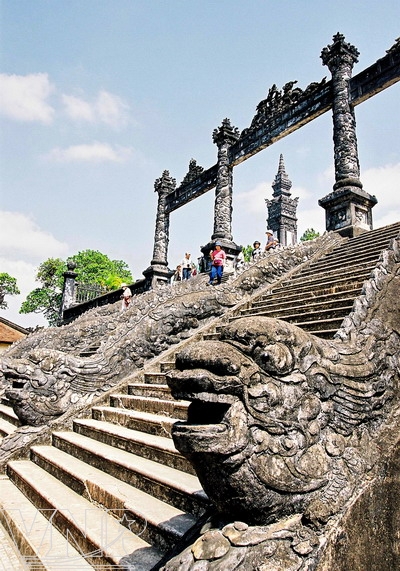 Khai Dinh’s tomb, the only architectural work with the combination of the Oriental and Occidental architecture, is the final resting place of King Khai Dinh (1885-1925), the 12th emperor of the Nguyen Dynasty. Photo: Trang Linh |
The tomb is known for its intricate art of glazed terra-cotta and three magnificent frescos titled “nine dragons in clouds” on the ceilings of three compartments in the Thien Dinh Palace. These frescos are the largest in Vietnam.
In addition to the tombs, Hue also has hundreds of well-known ancient architectural works, such as Nam Giao Platform, Thien Mu Pagoda, Ho Quyen Arena, Van Thanh Temple, Vo Thanh Temple, Binh Dai Town, Hai Thanh Town, Voi Re Temple, Hon Chen Temple and An Dinh Palace. These places, together with the surrounding romantic landscape, have made Hue an ancient, splendid and poetic capital city, worthy of being a World Cultural Heritage Site.
Story: Manh Thuong
Photos: Trang Linh – Manh Thuong’s file
Photos: Trang Linh – Manh Thuong’s file
Story: Manh Thuong - Photos: Trang Linh – Manh Thuong’s file

